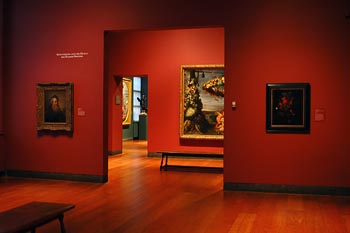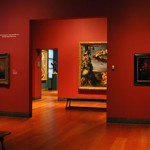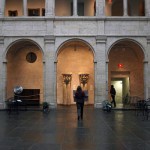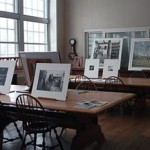By JESS T. DUGAN
Big Red & Shiny writer Jess T Dugan sits down with Daron Manoogian, Director of Communications at the Harvard University Art Museums (HUAM), home to the Fogg, Busch-Reisinger, and Sackler Museums. Jess and Daron to discuss the upcoming renovation of the building on Quincy St. to better integrate these collections under a new state of the art facility, the challenges to overcome, and the hopeful outcomes will become of it. - Ed.
-
Jess T. Dugan: What is the main focus of the Harvard University Art Museums?
Daron Manoogian: We have a teaching and research mission. Although we support the students, faculty, and curriculum of the Department of the History of Art and Architecture at Harvard, our teaching and research initiatives, exhibitions, and programming extend to the Harvard community and the public at large.
JTD:Can you speak about the history of the Harvard University Art Museums?
DM: We are comprised of three museums and four research centers, and the Art Museums had a leading role in the development of the discipline of art history in this country. The Fogg Art Museum, Harvard’s oldest, opened in 1895 and moved to the historic building on Quincy Street in 1927; the Busch-Reisinger Museum, originally founded in 1901 as the Germanic Museum, relocated to Werner Otto Hall on Quincy Street in 1991, and the Arthur M. Sackler Museum on Broadway opened in 1985. There are approximately 260,000 objects in our collection, which makes it among the six largest collections of art in the US.
JTD: Can you speak about the upcoming renovation and what the motivating factors are?
DM: Following years of extensive academic planning, we are about to begin a historic renovation and transformation of our facilities. On June 30, 2008, we will close our building at 32 Quincy Street—the current home of the Fogg Art Museum and the Busch-Reisinger Museum—to begin a long-awaited and much-needed renovation. It will enable us to create a state-of-the-art facility for all three of our museums—the Fogg, Busch-Reisinger, and Sackler. At the same time, we will need to begin preparations for the relocation of the majority of our collection and staff. During the renovation, we will provide ongoing access to many fine works from our collections at the Sackler Museum. In the spring and summer of 2008, we will begin a complete reinstallation of the Sackler to include representative works from the collections of all three of our museums. In order for us to complete this vast reinstallation, the Sackler will temporarily close for a few short weeks beginning on June 30, 2008. We are looking forward to a formal opening of the reinstallation in September 2008.
While construction dates for the Quincy Street renovation are contingent upon the community approval process, we hope construction will be underway sometime in 2009 and the newly renovated building will open in 2013. The movement of our collections, the age of the building, the care that must be taken to preserve its historic elements, and the complexity of the project are all contributing factors to this lengthy period of renovation.
Fundamental to this project are our goals of increased accessibility to our collections for students, scholars, and the public; enhanced collaboration and interdisciplinary work across all of our curatorial departments; and a larger role for the Art Museums in Harvard’s undergraduate curriculum and educational mission.
JTD: Do you feel that viewers have higher expectations of museums than they used to, and if so, how does this contribute to the need for change?
DM: I think in general, museums are experiencing a surge in popularity, and each organization has different characteristics and ways in which it tries to engage visitors. We try to encourage a dialogue, different interpretations, and open discussion. In terms of our structural changes, it’s primarily about protection of the collections for future study and appreciation by students, scholars, and the public, but it is also about remaining relevant by reaching out to new audiences and increasing access to the collections. This is not strictly an architectural project; it is based on many years of academic planning.
JTD: How will the new building at 32 Quincy Street be different than the current one?
DM: The new building at 32 Quincy Street will bring our three museums and their curatorial departments together under one roof in a state-of-the-art facility, designed by architect Renzo Piano. For too long those museums and their collections have been physically and programmatically separated. The obvious improvement is the addition of climate control, but we’ll also improve building accessibility, and add visitor amenities including a new museum shop and café, as well as new bathrooms and elevators.
JTD: The Mongan Center, one of the study centers in the Quincy Street building, is an active and vital resource for many students, scholars, and public visitors. When most of the collection is not available, what effect do you think its absence will have on the study of art and art history and how do the Harvard University Art Museums intend to address this issue?
DM: We know limited accessibility is difficult for students, scholars, and visitors to cope with, and we wish it could be avoided, but unfortunately it is unavoidable. Our new facilities will far better protect and preserve the collection and will offer increased access through larger galleries and an expansion of the study centers. In essence, the resources that are now offered in the Mongan Center will grow exponentially.
The complexity of this renovation project means that access to the collection will be limited, but the protection of the collection must prevail. In order to complete the renovation of the aging 32 Quincy Street building, it must be emptied and the majority of the collections must be relocated. This will seriously affect our ability to provide the type of access that we currently offer. We will offer continued access to many important works in our collection in the Sackler Museum galleries, and the reinstallation plan for the Sackler also includes a teaching gallery to be shared by the Department of the History of Art and Architecture and the Art Museums.
JTD: In a changing museum landscape, how will this renovation improve the social and historical relevance of the Harvard University Art Museums?
DM: HUAM do not operate like large municipal museums. This affords us the ability to focus on our teaching and research mission. New and renovated facilities will offer greatly enhanced flexibility for viewing, studying, and interacting with the collections and provide dynamic museum experiences for our visitors. We feel that with our focus on teaching, to both students and the public alike, and research, we will continue to fill a very important role in the study, conservation, and appreciation of art.
JTD: The building at 32 Quincy Street is considered by many to be a work of art. How is this being taken into consideration for the redesign and renovation?
DM: We are committed to preserving the historic elements of the building. The 32 Quincy Street building is a historic property, which requires that Harvard consult with the appropriate historic preservation agencies on exterior changes. The improvements to the building will be designed with sensitivity to its historical and planning contexts. The Fogg’s courtyard will be maintained as the central feature of the new facility.
- A view of the gallery: Seventeenth Century Dutch and Flemish Painting Gallery
- Courtyard inside the main entry of the Fogg Museum
- Prints and photographs out on display in the Agnes Mongan Center Print Study Room
Harvard University Art Museums
The Fogg Art Museum is located at 32 Quincy Street and Broadway, on the Harvard Campus in Cambridge, MA. The Arthur M. Sackler Museum is across the street from the Fogg at 485 Broadway. The Busch-Reisinger Museum in Werner Otto Hall is located behind the Fogg Art Museum on Prescott Street, and is entered through a doorway on the second floor of the Fogg.
All images are courtesy of the author and HAUM







